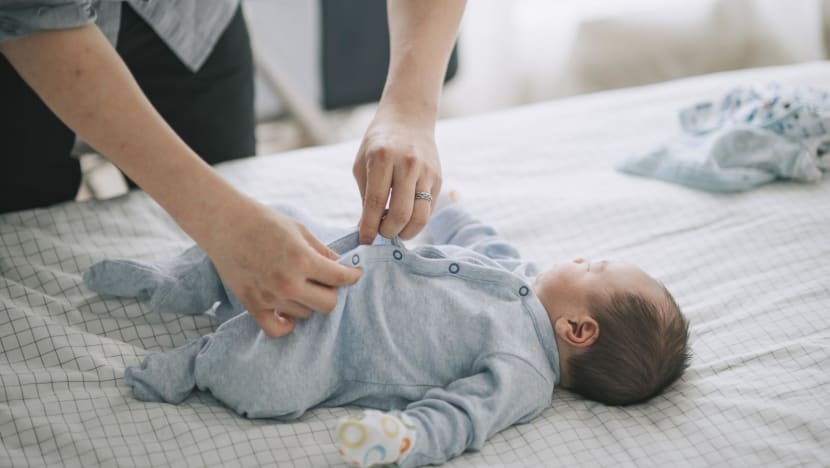Commentary: Dads, please take your increased paternity leave if you can
Not all employees may feel supported to fully use their four weeks of government-paid paternity leave. Those who do can help normalise that behaviour, says new father Bernard Aw.

This audio is AI-generated.
SINGAPORE: “Do not go out and play golf. Please use it to take care of your kid,” said Prime Minister Lee Hsien Loong in 2015 when he announced an increase from one to two weeks of government-paid paternity leave.
The same plea could be made (half in jest) this year as Singapore once again doubled paternity leave - from two to four weeks. Having become a new father a few months ago, I missed out on this expanded leave, but still, golf was the farthest thing from my mind.
Fathers who are in a position to take the enhanced paternity leave now, please take it. The more we do, the less big of a deal it becomes. Hopefully, that will nudge less supportive employers along.
Biology may dictate that mothers bear the brunt of pregnancy and in the early months after giving birth, but being a new father also demands full-time commitment – being present as a parent to learn and do, not merely to “help”.
The move to expand paternity leave hopes to reinforce the message that paternity involvement should be the norm in our society.
While there is improvement in the take-up rate of paternity leave in Singapore, it is still far from being the norm. Around half of fathers took paternity leave in 2019, up from 25 per cent in 2013.
Only 40 per cent took the full two weeks each year from 2018 to 2020. Why did the rest not do so?
FATHERS’ ABSENCE AT WORK
For one, fathers who want to be more involved in their children’s early weeks and years must grapple with the same challenge that has long plagued mothers: How their absence at work will be perceived.
Research by the Ministry of Social and Family Development showed that the key reason fathers who want to use their paternity leave but did not was because of workplace culture. They may be fearful of the impact on their career prospects or whether colleagues are willing to cover their duties in their absence.
I, too, had my initial reservations about being absent from work for so long given my regional responsibilities. Would my team be able operate seamlessly in my absence? How would I be looked upon since men are not often perceived as essential in caring for a newborn?
I was among the fortunate ones to have strong workplace support. My manager was supportive of me taking time off work, offered parenting tips (being a father himself) and even travelled from Paris to Singapore to cover for me for a client presentation.
It helped immensely that I communicated early to my bosses and team as to how the coverage of my job responsibilities would be distributed so arrangements could be made. My colleagues also provided me with assurances that there would not be any disruption to the workflow.
For fathers to be more involved in parenting, a pronounced change in workplace culture is needed to reduce the stigma against paternity leave.
BEING PRESENT AS A PARENT
Since I was in a supportive environment to unabashedly take paternity leave, I fully seized the opportunity to be fully present for the first month of my daughter’s life – two weeks of paternity leave and additional two weeks of annual leave. Even then, it did not feel like enough.
New parents undergo an extreme form of on-the-job training, picking up on how to do things when the baby is born. It might sound straightforward on paper: What’s so difficult about changing a few soiled diapers, doing night feeds or carrying a newborn?

It’s not easy and requires new dads to take the time to learn and adapt. I learnt a lot of it by trial and error and the early weeks of life are full of quick changes to the baby’s behaviour.
What is the best way to carry my baby to calm her down? Why did that way work the last time but not now? Do we schedule feedings to create a sense of routine or do on-demand feeding? Why is the baby still crying?
Mothers are already pre-occupied with many tasks that only they can perform, including breastfeeding and expressing milk every few hours even in the middle of the night. The pressures of motherhood can also come with an incessant voice in the back of your head saying “you’re doing it wrong”.
In Singapore, one in eight women suffer from prenatal depression while postnatal depression affects one in 14 women. Many more mothers may also experience mild “post-natal blues”.
Having a partner who takes on a hands-on role in fatherhood is important for the well-being of not just the baby but also the mother. The more weight fathers can take off mothers’ shoulders, especially in the early months, the more will be done for the healthy development of the growing family.
NORMALISING PATERNITY LEAVE
The increase in paternity leave is a step in the right direction towards gender equality in child-rearing responsibilities. Helping dads actually take paternity leave moves us all a bit further forward toward greater involvement.
We already know that fathers play a critical role in childhood. Many studies showed that children with greater father involvement have healthier cognitive, social, and behavioural developmental outcomes.
Encouragingly, more fathers are pulling their share of caregiving than in the past, according to a global survey. But beyond the workplace, a reframing of mindsets about gender roles in parenting is also necessary as dual-career couples become more common.
Bernard Aw is a new father and also Chief Economist for Asia Pacific at Coface.








